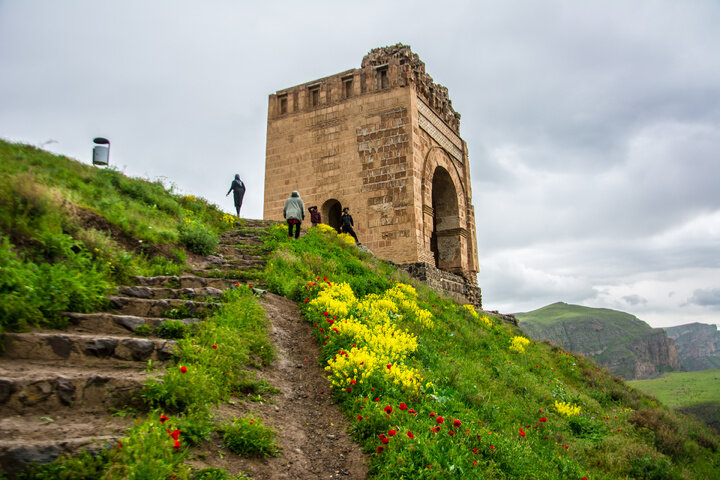Tehran – Zahak Castle, located in Hashtrud, East Azabaijan, is one of the prominent examples of rocks and military architecture. Today it is at the heart of the restoration, research and development-oriented programme of East Azabaijan’s cultural heritage, tourism and handicrafts bureau.
Zahak Castle is intended not only to be on the path of cultural revival, but also to become one of the country’s cultural tourism hubs, CHTN reports.
Vahid Navadad, deputy director of the Cultural Heritage, Tourism and Handicrafts Bureau of East Azarbaijan, said, “We intend to introduce and promote the infrastructure associated with this historic castle.”
Based on stratigraphic studies and historical documents, renovations are underway at the castle’s main entrance and the East wing, he said.
He added that preserving Zahak Castle means preserving some of the historical memory of the region and the cultural identity of Azarbaijani.
“Our approach is to make minimal restoration in terms of the originality of the material and the historical form of the monument,” he said.
The unique tourism potential of Zahak Castle could turn into one of the area’s pillars of sustainable development, he said.
Also, Alileza Bairamzadeh, deputy director of the East Azarbaijan Tourism Bureau, said Zahak Castle was not merely a place of visit, but a living experience, a combination of history, nature, mythology and architecture. “Our plan is to prepare the basis for encouraging cultural tourists by improving access routes, setting up multilingual information boards and developing basic infrastructure.”
“We are compiling ecotourism plans with community involvement to not only lead to economic prosperity in the region, but also to lay the foundation for the transfer of cultural values. We are planning a specialized tour focused on mythical and historical research to attract elite tourists to the region.”
Also, Ahmad Hamezadeh, director of the Cultural Heritage, Tourism and Handicrafts Bureau of East Azabaijan, said, “We see Zahak Castle not only as a historical monument but as a living asset to replicate the local identity.”
“There are ongoing negotiations to attract cultural investors with the aim of launching the museum’s site, implementing evening tourism programs, and even developing access routes to the region. Aside from maintaining the castle’s historic originality, these measures could turn into a driving force for economic growth in Hashturd and its surrounding areas,” he concluded.
Zahak Castle, named after the mythical figure of ancient Iranian mythology, continued to occupy the Timulid era and dates back to the second millennium BC.
Featuring intricate brickwork, archways and stairs, the fortress offers insight into ancient defensive architecture and social structures.
The strategic importance of the castle during the Parthian period is highlighted by historical accounts, including its role in the defeat of Roman general Mark Anthony in 37 BC.
Median infantry, allied with the Parthian Cavalry, played a key role in this victory, giving us a rare glimpse into the military strategy of that era.
Archaeological excavations launched by British researchers decades ago revealed artifacts such as traces of colouring, as well as stucco remains shedding light on the site’s artistic and cultural heritage.
Glimpse into the Parthian era
The Parthian Empire, also known as the Arsasid Empire, was Iran’s main political and cultural force, centered around ancient Iran from 247 to 224 BC. The name comes from Arsaces I, the founder who led the Parni tribes who conquered Parthia, the northeastern region of Iran. At the time, Parthia was a Satrapy (province) under Andragoras, an insurgent force against the Seleucian Empire.
In Zenith, the Parthian Empire stretched from the Northern Euphrates River (modern Eastern Central) to the present day Afghanistan and West Pakistan. The empire, located along the Silk Road, flourished as a hub of trade and commerce that linked the Mediterranean Roman Empire to the Han Dynasty of China.
The Parthians absorbed various elements of the diverse cultures within the Empire. Initially, the Al-Sasid Court adopted many aspects of Greek culture, but gradually saw a revival of Iranian tradition. The Parthian rulers adopted the title “King of Kings” and claimed legacy from the Achaemenid Empire. Unlike Achemenid, who ruled through the centrally appointed Satrap, the Parthians often allowed local kings to serve as vassals. As the empire expanded, the central government moved from the NISA to Ctesiphon near modern-day Baghdad, but other cities also served as capitals.
KD

